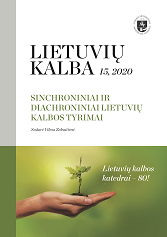KNYGŲ IR JŲ AUTORIŲ ASMENINĖ ORTOGRAFIJA XIX A. PABAIGOJE–XX A. PRADŽIOJE
ORTHOGRAPHY OF BOOKS AND THEIR AUTHORS AT THE END OF THE 19TH AND THE BEGINNING OF THE 20TH CENTURY
Author(s): Jurgita VenckienėSubject(s): Language studies, Recent History (1900 till today), Baltic Languages, 19th Century, Philology
Published by: Vilniaus Universiteto Leidykla
Keywords: Lithuanian language; 19th century; 20th century; books; ortography;
Summary/Abstract: During development of the Standard Lithuanian language at the end of the 19th century, the dialectal basis was chosen first, and the orthography varied yet for another twenty years. This article analyses the dual orthography – of books and personal orthography of their authors. The study is designed to find out whether the books published during that period reflect the orthographic model chosen by their authors; what factors, in addition to the author’s choice, may have influenced the orthography of the books. The influence of printers on the orthography of books during that period was smaller than before, as many authors did the proofreading themselves. Thus, printers were able to change the orthography in cases where books were printed without the author’s knowledge or consent, such as prayer books. If the author chose unusual, rare, or even self-invented characters, a limited inventory of prints could be a serious obstacle to keep their orthography in the book. As the case of Jonas Basanavičius shows, even when the author offered to finance the acquisition of the necessary prints, this was not necessarily done. At the end of the 19th century, books were published as supplements to periodicals. The editors of newspapers Ūkininkas and Tėvynės sargas adapted the orthography of such books to their periodicals. Under the terms of the press ban, it was often important for authors just to print a book, and the spelling model was chosen by the publisher. However, authors such as Basanavičius, who considered themselves the creators of the standard language, took care to present their chosen or created model of orthography in their books as well. As the cases of Liudvika Didžiulienė, Dominykas Tumėnas and Basanavičius show, two orthographic standards emerged during the research period: correspondence was written one way and books were printed another. Hence, it is not always possible to judge the orthographic model chosen by the authors in books published at the end of the 19th century and the early 20th century.
Journal: Lietuvių kalba
- Issue Year: 2020
- Issue No: 15
- Page Range: 1-15
- Page Count: 15
- Language: Lithuanian

